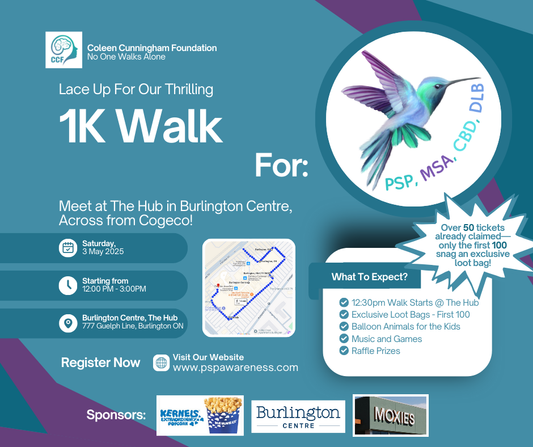It has been said there are four stages, but because there is so little research they are a guideline only.
Many people experience some stage four symptoms at stage one or overlap stages. Some never experience certain symptoms and then others can experience ones not listed. The impact it has on each individual varies dramatically.
Progressive Supranuclear Palsy (PSP) is a rare neurodegenerative disorder that affects movement, balance, vision, speech, and cognitive function. The disease progresses slowly over time, and its symptoms typically become more severe as the disease advances. While not everyone with PSP experiences the same symptoms or progression, there are generally four recognized stages of PSP:
-
Early stage: In the early stage of PSP, individuals may experience symptoms such as difficulty with balance and coordination, changes in gait, and problems with eye movement. These symptoms may be subtle and easily dismissed as normal aging or a different condition.
-
Mid-stage: In the mid-stage of PSP, symptoms become more pronounced and can include falls, speech and swallowing difficulties, and cognitive impairment such as problems with memory and executive function. Depression and apathy are also common.
-
Advanced stage: In the advanced stage of PSP, individuals may become wheelchair-bound and require assistance with daily activities such as eating, dressing, and bathing. Symptoms such as rigidity, spasticity, and involuntary movements become more severe.
-
End-of-life stage: In the end-of-life stage of PSP, individuals may be bedridden and require around-the-clock care. They may have difficulty swallowing, become more susceptible to infections, and experience other complications related to the progression of the disease.
It's important to note that not everyone with PSP will experience all of these stages, and the progression of the disease can vary widely from person to person. Additionally, some individuals may experience rapid progression, while others may experience a slower course of the disease.
Here is the four stages below in more detail;
Early stage:
May present via the fracture clinic, falls services, eye specialist or speech and language therapist. The early stage typically spans years 0-1.
> Ambulant.
> Occasional falls.
> Unsteadiness and poor balance.
> Possible visual problems affecting ability to read.
> Voice changes, for example reduced volume.
> Mood changes.
> Reduced socializing.
> Changes in mood and behavior, including apathy and anxiety.
Mid stage:
Many people reach this stage before diagnosis. Consider discussing advance care planning and advance decisions to refuse treatment. Consider referral to palliative care services. The mid stage typically spans years 2-3.
> Ambulant with aids.
> High risk of falls and injury.
> Visual problems affecting self-care abilities, for example eating and walking as unable to move eyes to see.
> Speech increasingly unintelligible.
> Inability to initiate conversation.
> Impulsivity (risky or impulsive behavior).
> Apathy.
> Dysphagia.
> High level of supervision required.
> Increasingly socially withdrawn.
Advanced stage:
Patients should be on GP palliative care register and have access to specialist palliative care.
The advanced stage typically spans years 3-6.
> Mobility significantly compromised, probably chair bound requiring a wheelchair for mobility.
> Significant visual problems.
> Significant muscle stiffness.
> Significant communication problems, but probably still able to understand.
> High risk of aspiration and pneumonia as a result of dysphagia.
> Pain.
> Increasing periods of sleepiness.
> Incontinence.
> Severely withdrawn socially.
> Dependent for most or all aspects of care.
End of life stage:
This stage is difficult to detect, but may be indicated by reduced levels of consciousness, inability to eat or drink, acute infection, a fall or major fracture, and rapid and significant weight loss. The end of life stage typically spans 6-8 weeks.
> Severe impairments and disabilities.
> Rapid and marked deterioration in condition.
> Decisions with regard to treatment interventions may be required, considering an individual’s previously expressed wishes (advance decisions to refuse treatment).
Discover the Benefits of Vielight Red Light Therapy for Atypical Parkinsonism


 Donate
Donate




122 comments
Thank you for sharing your sister’s journey with PSP. As difficult as it was to read it was helpful to know what this disease entails. My husband has it and is stage 2. So hard to watch him slip away from me. Thank you again for your honesty.
Thank you for sharing your sister’s journey with PSP. As difficult as it was to read it was helpful to know what this disease entails. My husband has it and is stage 2. So hard to watch him slip away from me. Thank you again for your honesty.
Boa tarde meus sentimentos a todas as famílias e minhas orações a todos que estão passando por esse martírio, meu pai está enfrentando essa doença ele tem 70 anos faz uns 5 anos que começamos a tratar , mas infelizmente não dá pra fazer muita coisa a doença é devastadora meu pai já não consegue fazer nada sozinho, é muito triste de ver misericórdia peço a Deus que de força a todos nós e a todos que estão passando por isso estamos destruídos.
My mum was diagnosed of PSP in last week of February. She is 78 years old and has multiple health issues. She is a diabetic, hypertensive, has CKD, COPD, OSA on bipap… Her PSP is rapidly progressing. She can’t walk without a walker and even with support, she falls.. she is also delusional and sometimes hallucinates. She sleep talks a lot. She was a teacher and retired at 74. I can’t believe how a disease can change a person so quick. It’s really hard to digest that such an active woman is now like a baby. I hope they find a cure for the disease in the future. I also hope that mum wouldn’t suffer too much for too long.
My aunt is currently suffering from PSP. Although I work in healthcare, I have never heard of this disease. She is under palliative care now and seems to be going downhill quickly. 2 months ago she required 1 assist to stand and pivot. Could walk with a walker on some days. She is now going through times of being unable to get out of bed. She told me back in October this was no way to live. I pray for her every day and I hope that there is a cure some time in the future as this is a horrible debilitating disease. I hope all people suffering from PSP can find some relief from its painful presence.